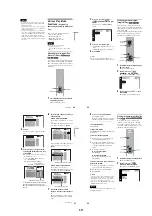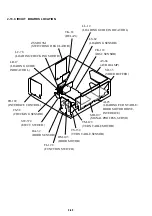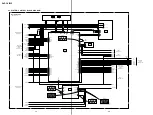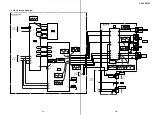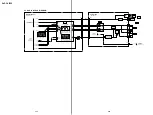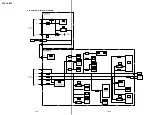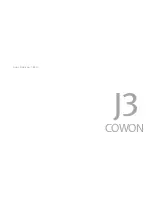
1-24
97
Ad
d
itio
n
a
l In
fo
rm
a
tio
n
Operation
The remote does not function.
,
The batteries in the remote are weak.
,
There are obstacles between the remote and
the player.
,
The distance between the remote and the
player is too far.
,
The remote is not pointed at the remote
sensor on the player.
,
The COMMAND MODE switch setting on
the remote does not match the setting on the
player (page 17).
The disc does not play.
,
The disc is skewed.
,
The player cannot play certain discs (page
6).
,
The region code on the DVD does not match
the player.
,
Moisture has condensed inside the player
(page 3).
,
The player cannot play CD-Rs, CD-RWs,
DVD-Rs, or DVD-RWs (video mode) that
are not finalized (page 7).
The MP3 audio track cannot be played
(page 43).
,
The DATA CD is not recorded in the MP3
format that conforms to ISO9660 Level 1/
Level 2 or Joliet.
,
The MP3 audio track does not have the
extension “.MP3.”
,
The data is not formatted in MP3 even
though it has the extension “.MP3.”
,
The data is not MPEG1 Audio Layer 3 data.
,
The player cannot play audio tracks in
MP3PRO format.
“Copyright lock” appears and the screen
turns blue when playing a DVD-RW disc.
,
Images taken from digital broadcasts, etc.,
may contain copy protection signals, such
as complete copy protection signals, single
copy signals, and restriction-free signals.
When images that contain copy protection
signals are played, a blue screen may appear
instead of the images. It may take awhile
while the player looks for playable images.
The title of the MP3 audio album or track
is not correctly displayed.
,
The player can only display numbers and
alphabet. Other characters are displayed as
“*.”
The disc does not start playing from the
beginning.
,
Program Play, Shuffle Play, Repeat Play, or
A-B Repeat Play has been selected (page
45).
,
Resume play has taken effect (page 39).
The player starts playing the disc
automatically.
,
The disc features an auto playback function.
,
“AUTO PLAY” in “CUSTOM SETUP” is
set to “ON” (page 92).
Playback stops automatically.
,
While playing discs with an auto pause
signal, the player stops playback at the auto
pause signal.
The FLIP button does not operate.
,
The disc you are trying to flip does not have
a side B.
You cannot perform some functions such
as Stop, Search, Slow-motion Play,
Repeat Play, Shuffle Play, or Program
Play.
,
Depending on the disc, you may not be able
to do some of the above operations. See the
operating manual that comes with the disc.
The language for the sound track cannot
be changed.
,
Try using the DVD’s menu instead of the
direct selection button on the remote (page
40).
,
Multilingual tracks are not recorded on the
DVD being played.
,
The DVD prohibits the changing of the
language for the sound track.
The subtitle language cannot be changed
or turned off.
,
Try using the DVD’s menu instead of the
direct selection button on the remote (page
40).
c
continued
98
,
Multilingual subtitles are not recorded on
the DVD being played.
,
The DVD prohibits the changing of the
subtitles.
The angles cannot be changed.
,
Try using the DVD’s menu instead of the
direct selection button on the remote (page
40).
,
Multi-angles are not recorded on the DVD
being played.
,
The angle can only be changed when the
“ANGLE” indicator lights up on the front
panel display (page 10).
,
The DVD prohibits changing of the angles.
The player does not operate properly.
,
When static electricity, etc., causes the
player to operate abnormally, unplug the
player.
Nothing is displayed on the front panel
display.
,
“DIMMER” in “CUSTOM SETUP” is set
to “OFF” or “AUTO OFF.” Set
“DIMMER” to any setting other than
“OFF” or “AUTO OFF” (page 92).
5 numbers or letters are displayed on the
screen and on the front panel display.
,
The self-diagnosis function was activated.
(See the table on page 98.)
The front cover does not open and
“LOCKED” appears on the front panel
display.
,
Child Lock is set (page 36).
The front cover does not open and “TRAY
LOCKED” appears on the front panel
display.
,
Contact your Sony dealer or local
authorized Sony service facility.
“Data error” appears on the TV screen
when playing a DATA CD.
,
The MP3 audio track you want to play is
broken.
,
The data is not MPEG1 Audio Layer 3 data.
Self-diagnosis Function
(When letters/numbers appear in the
display)
When the self-diagnosis function is activated
to prevent the player from malfunctioning, a
five-character service number (e.g., C 13 50)
with a combination of a letter and four digits
appears on the screen and the front panel
display. In this case, check the following
table.
First three
characters of
the service
number
Cause and/or corrective
action
C 13
The disc is dirty.
,
Clean the disc with a soft
cloth (page 8).
C 31
The disc is not inserted
correctly.
,
Re-insert the disc
correctly.
C 32
The front cover
automatically opens and the
player enters standby mode.
,
Check that there is
nothing wrong inside the
rotary table, such as a
fallen disc. After you
have checked the inside
of the rotary table and
resolved any possible
problems, press
H
.
E XX
(xx is a number)
To prevent a malfunction, the
player has performed the
self-diagnosis function.
,
Contact your nearest
Sony dealer or local
authorized Sony service
facility and give the 5-
character service number.
Example: E 61 10
99
A
dd
itio
n
a
l In
fo
rm
a
tio
n
Glossary
Chapter (page 10, 14, 63)
Sections of a picture or a music feature that
are smaller than titles. A title is composed of
several chapters. Depending on the disc, no
chapters may be recorded.
Dolby Digital (page 28, 94)
Digital audio compression technology
developed by Dolby Laboratories. This
technology conforms to 5.1-channel surround
sound. The rear channel is stereo and there is
a discrete subwoofer channel in this format.
Dolby Digital provides the same 5.1 discrete
channels of high quality digital audio found in
Dolby Digital cinema audio systems. Good
channel separation is realized because all of
the channel data are recorded discretely and
little deterioration is realized because all
channel data processing is digital.
Dolby Surround (Pro Logic) (page 27, 94)
Audio signal processing technology that
Dolby Laboratories developed for surround
sound. When the input signal contains a
surround component, the Pro Logic process
outputs the front, center and rear signals. The
rear channel is monaural.
DTS (page 28, 71, 95)
Digital audio compression technology that
Digital Theater Systems, Inc. developed. This
technology conforms to 5.1-channel surround
sound. The rear channel is stereo and there is
a discrete subwoofer channel in this format.
DTS provides the same 5.1 discrete channels
of high quality digital audio.
Good channel separation is realized because
all of the channel data is recorded discretely
and little deterioration is realized because all
channel data processing is digital.
DVD VIDEO (page 6)
A disc that contains up to 8 hours of moving
pictures even though its diameter is the same
as a CD.
The data capacity of a single-layer and single-
sided DVD is 4.7 GB (Giga Byte), which is 7
times that of a CD. The data capacity of a
double-layer and single-sided DVD is 8.5
GB, a single-layer and double-sided DVD is
9.4 GB, and double-layer and double-sided
DVD is 17 GB.
The picture data uses the MPEG 2 format, one
of the worldwide standards of digital
compression technology. The picture data is
compressed to about 1/40 (average) of its
original size. The DVD also uses a variable
rate coding technology that changes the data
to be allocated according to the status of the
picture. Audio information is recorded in a
multi-channel format, such as Dolby Digital,
allowing you to enjoy a more real audio
presence.
Furthermore, various advanced functions
such as the multi-angle, multilingual, and
Parental Control functions are provided with
the DVD.
DVD-RW (page 6, 41)
A DVD-RW is a recordable and rewritable
disc with the same size as the DVD VIDEO.
The DVD-RW can be recorded in two
different modes: VR mode and Video mode.
VR (Video Recording) mode enables various
programming and editing functions, some of
which are limited in the case of Video mode.
Video mode complies with DVD VIDEO
format and can be played on other DVD
players while a DVD-RW recorded in VR
mode can only be played on DVD-RW
compliant players. The “DVD-RW”
appearing in this manual, and the on-screen
displays refer to DVD-RWs in VR mode.
Film based software, Video based
software (page 91)
DVDs can be classified as Film based or
Video based software. Film based DVDs
contain the same images (24 frames per
second) that are shown at movie theaters.
Video based DVDs, such as television
dramas or sit-coms, displays images at 30
frames (or 60 fields) per second.
c
continued
100
Interlace format (page 91)
Interlace format shows every other line of an
image as a single “field” and is the standard
method for displaying images on television.
The even number field shows the even
numbered lines of an image, and the odd
numbered field shows the odd numbered lines
of an image.
Index (CD)/Video Index (VIDEO CD) (page
10, 14, 63)
A number that divides a track into sections to
easily locate the point you want on a CD or
VIDEO CD. Depending on the disc, no index
may be recorded.
Progressive format (page 91)
Compared to the Interlace format that
alternately shows every other line of an image
(field) to create one frame, the Progressive
format shows the entire image at once as a
single frame. This means that while the
Interlace format can show 30 frames (60
fields) in one second, the Progressive format
can show 60 frames in one second. The
overall picture quality increases and still
images, text, and horizontal lines appear
sharper. This player is compatible with the
480 progressive format.
Scene (page 10)
On a VIDEO CD with PBC (playback
control) functions, the menu screens, moving
pictures and still pictures are divided into
sections called “scenes.”
Title (page 10, 14, 63)
The longest section of a picture or music
feature on a DVD, movie, etc., in video
software, or the entire album in audio
software.
Track (page 10, 14, 63)
Sections of a picture or a music feature on a
CD or VIDEO CD (the length of a song).


